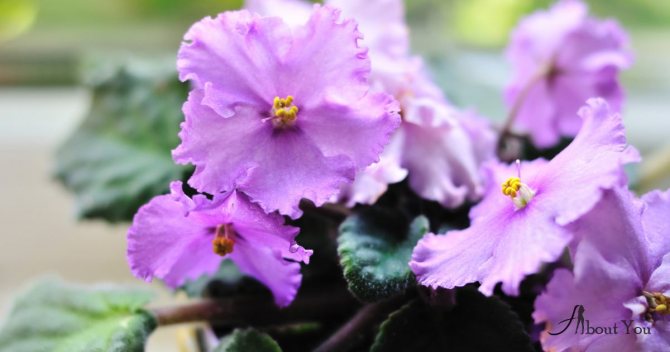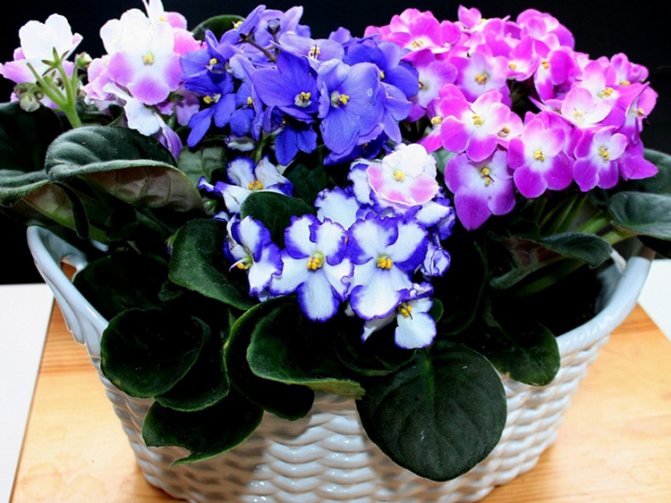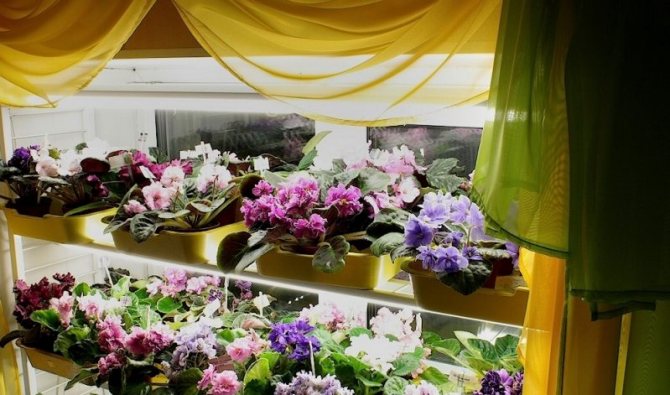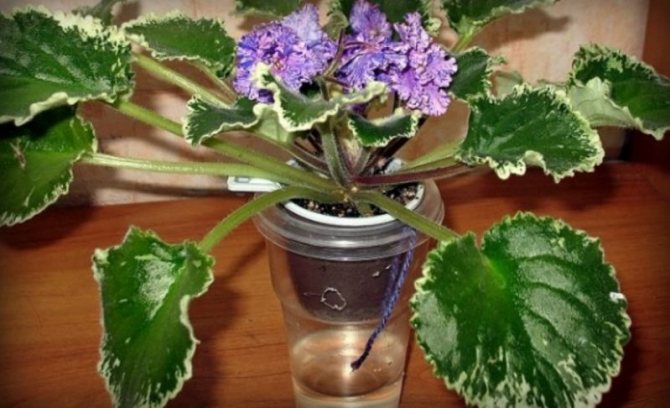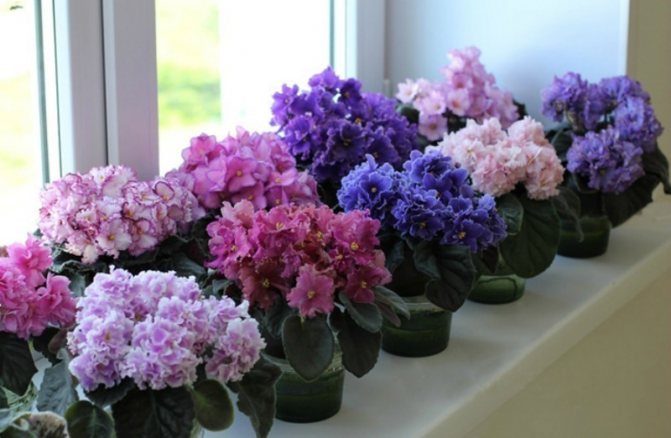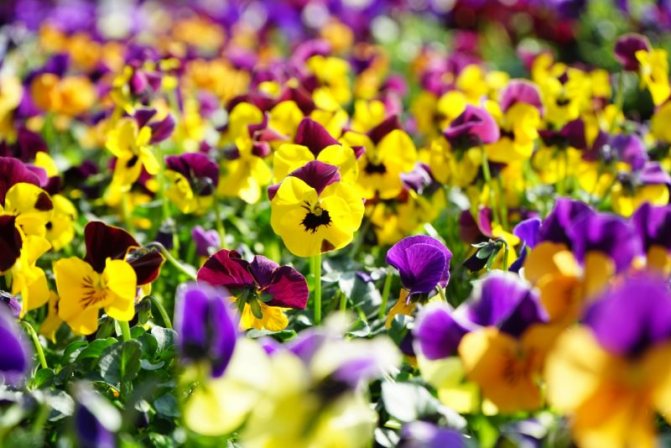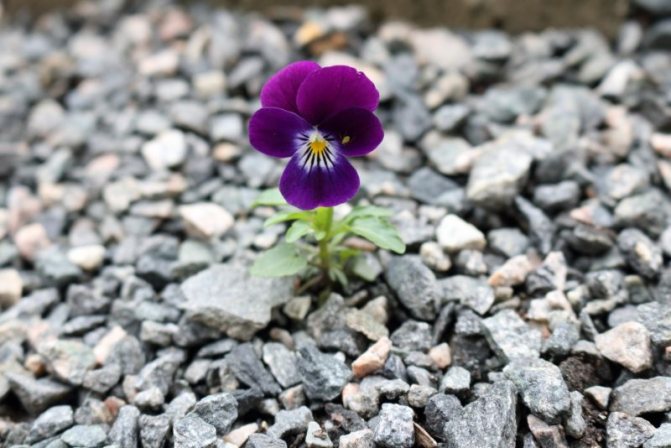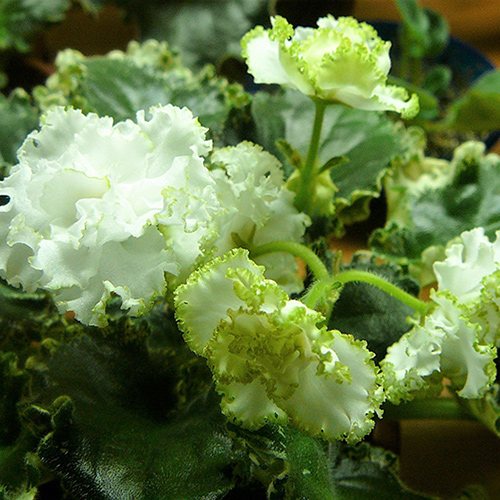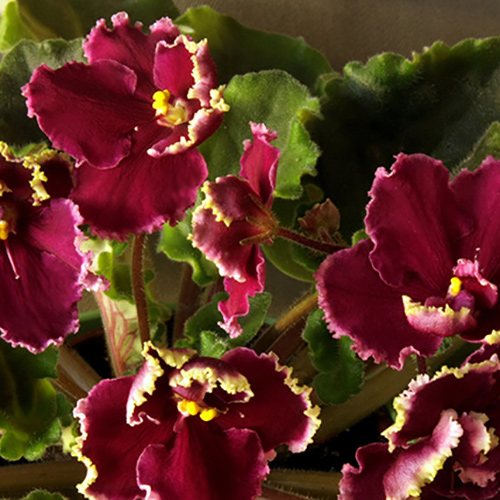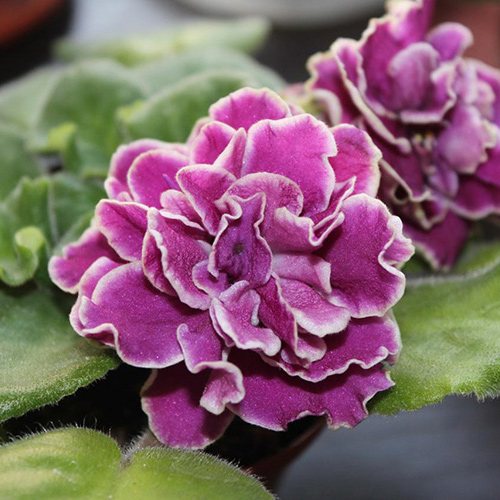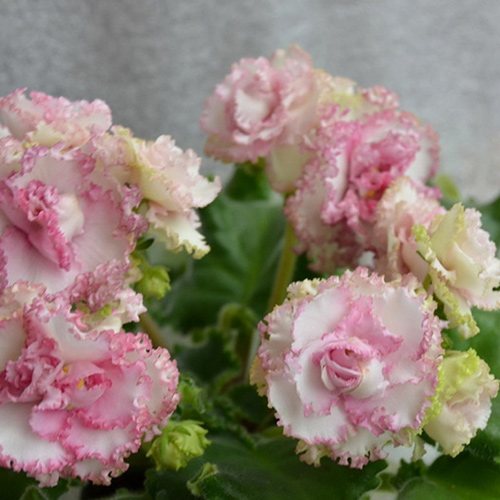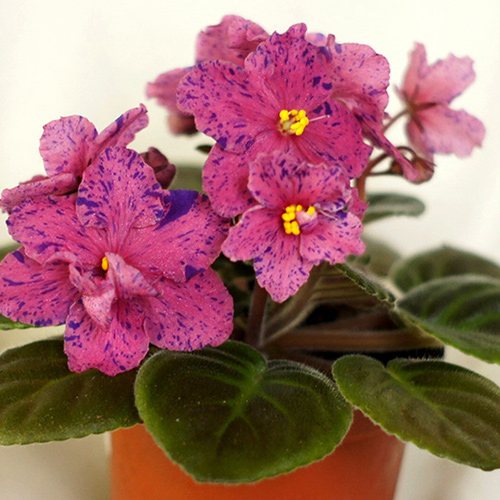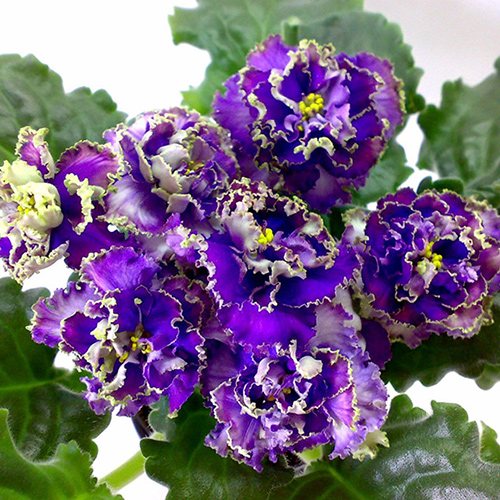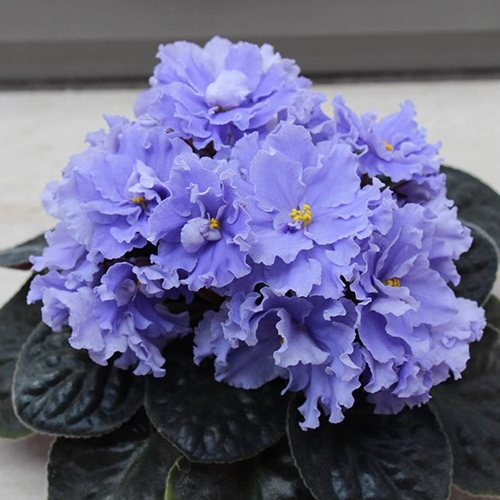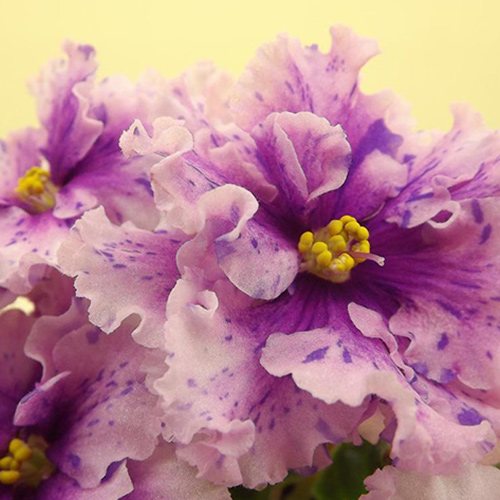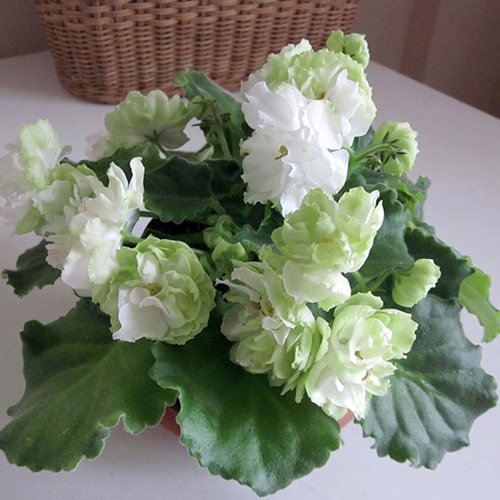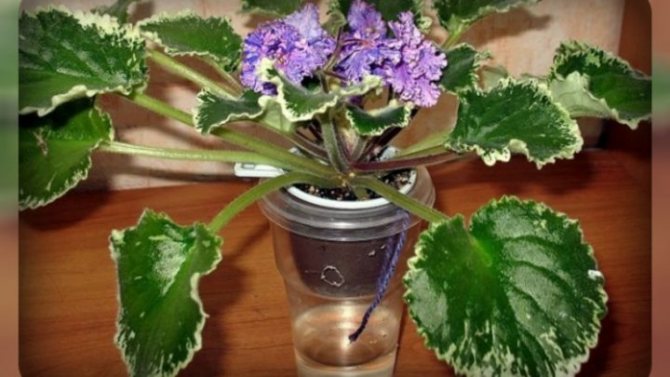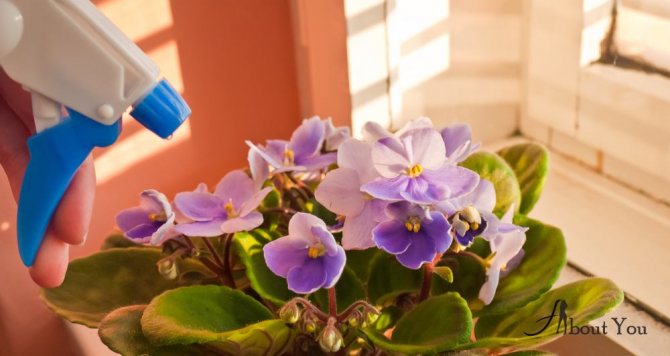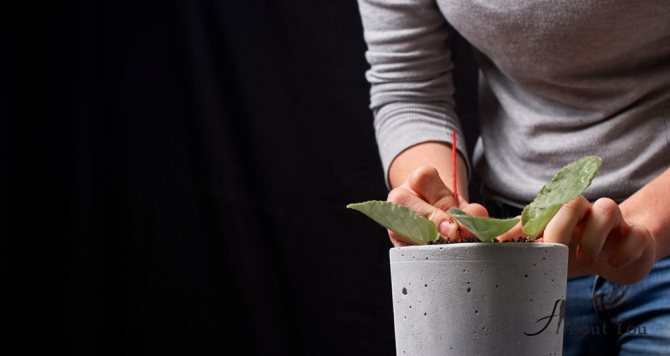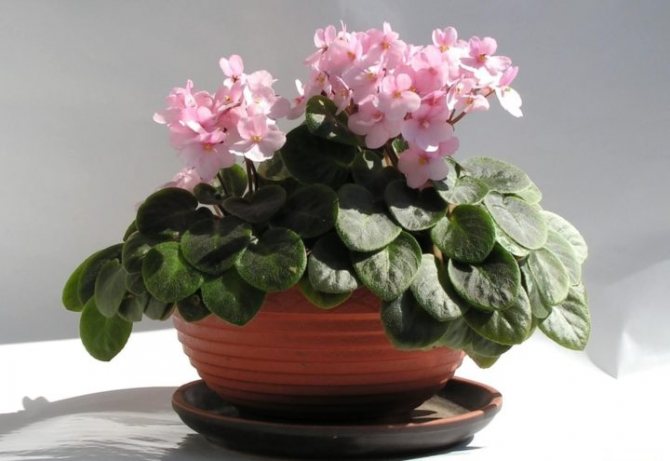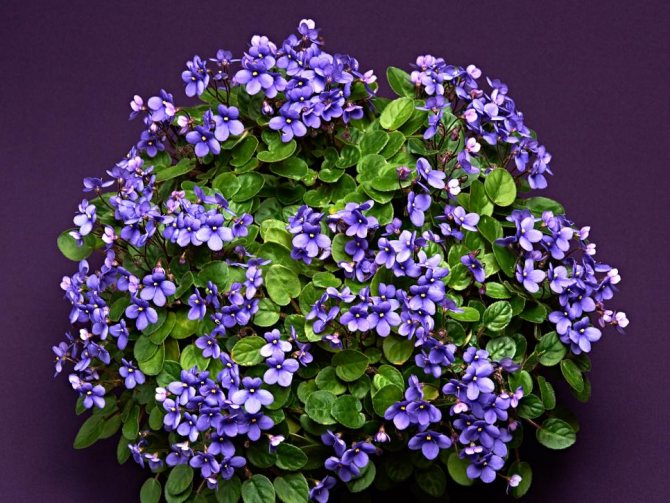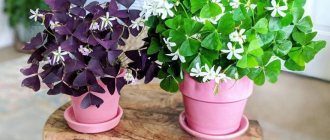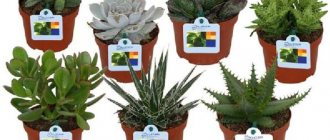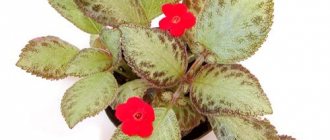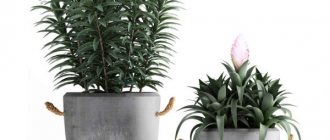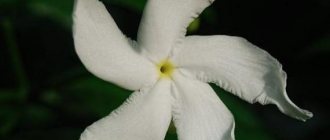Home »Flowers and plants
Flowers and Plants
Vladimir Serchenko

Violet at home, almost every grower has. This plant, called the uzambara violet, or saintpaulia, is a beautiful little beauty from an aesthetic point of view, it is a fairly easy flower to care for and reproduce. This visitor from East Africa has lived in our homes for no more than 100 years, however, she has already won millions of hearts.
- Description of the plant
- Violet care
- Soil and pot for violets
- Watering violets
- Reproduction of violets
- Growing from a leaf
- Reproduction by children
- Plant diseases
- Pests
Read also: Orchid care at home - tropical beauty on the windowsill (40+ Photos & Videos) + Reviews
Violet: a description of the plant and a brief botanical reference
Home violets are perennials. The plant is compact, some varieties are representatives of dwarf types with a creeping rhizome. The leaves are velvety, shaped like a heart. Their color can vary from salad to dark green, with various decorative blotches, depending on the variety. The flowers are painted in a wide variety of colors. The fruits are small seed pods.


Delicate violet will decorate any home
Indoor violets belong to the Gesneriaceae family. They come from the tropical forests of East Africa. The flowering period can last all year round if the growing conditions are right. The breeders managed to get more than a thousand types of flowers, differing from each other not only in decorative properties, but also in size, characteristics of growth.
Is it possible to keep violets at home is it good or bad folk omens, superstitions
According to superstition, violets provoke negative reactions
, in more detail:
- They have a bad effect on the emotional mood, in particular, flowers provoke a bad mood, quarrels, conflicts in the family.
- They carry a strong feminine energy, as a result of which the ladies who live in the house feel useless, and the men become depressed and spineless.
- For some reason, such flowers are also considered grave flowers, before they were planted in the cemetery in order to calm the souls of the dead. Therefore, carrying these plants into the house is a bad omen.
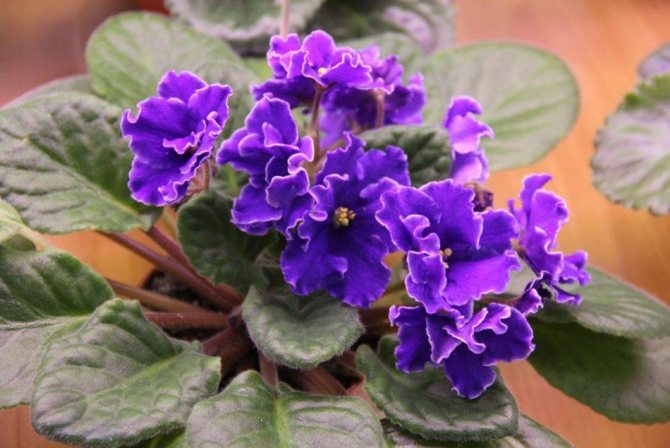

Despite all of the above, there are still signs from the past and opposite to the negative, in particular:
- According to oriental signs, the presence of a violet in the house contributes to the reign of peace, harmony in the family hearth. The flowers of the plant pacify those around them, smooth out conflict situations.
- If there is an acute shortage of money in the family, then the flower attracts flows of monetary energy. This is the statement of the Eastern sages.
- Flowers of white color - drive away suffering, relieve the owners of the house from bad thoughts.
- To attract money and curb your appetite, "acquire" violets with red flowers.
- Blue violets have a positive effect on people with creative potential, inspiring them to create new works of art.
- Among other things, to drive out uninvited guests - ants from the house, put a violet on the windowsill. You won't see these annoying insects again.
Violet varieties: names and photos
Breeding violets at home is a fascinating hobby of many people, which is gaining more and more popularity.Today, many of the most beautiful varieties of this plant are known. I would like to acquaint readers with the most popular of them.
| Variety name | Distinctive features |
| This is a decoration for any amateur collection. The flower petals are corrugated, the background is white. Pink strokes or numerous blue splashes give the inflorescences an unusual charm. |
| This flower conquers with the white foam of its lacy flowers with an amazing greenish fringe. |
| Burgundy or dark red brushes of flowers look great against a background of green leaves. The edging of flowers is white or pale pink, rather wide. An unusual charm is given by the fact that the flowers are corrugated along the edges. |
| This variety will appeal to lovers of large-flowered violets. The color of the huge hats of flowers is dark burgundy, one might even say beetroot, the edging along the edge is white. The rosette is standard, the leaves have a uniform green color. |
| During the flowering period, the violet bush resembles a gorgeous pink rose. At the fringed edges, the pink color becomes saturated, bright, sometimes a green edging appears. |
| Rarely does anyone not pay attention to the flowers of the coral pink color and enormous size that distinguish this variety. The colors are given individuality by blue and purple spots, which are generously sprayed with flower petals. With mutation, some managed to get bushes with buds of different colors. |
| The flowers are semi-double, very large, painted in a pleasant light blue shade with a thin green edging. In the process of mutation, the color gamut can significantly lighten, but it looks no less impressive. |
| The variety, familiar to connoisseurs for a long time, has not lost its popularity today. A cap of deep double flowers of a delicate pink color bewitches with beauty. |
| A very unusual variety with fringed flowers of a rich blue color, which smoothly turns into pink to the edges. A thin, bright green edging adds a special charm. Flowering is profuse and long lasting. |
| Truly giant flowers are pale blue, they look gorgeous against the background of dark green leaves. The corollas are similar in shape to a bell. |
| Indeed, looking at the semi-double-type star-shaped flowers, one immediately recalls the play of sunlight on the winter snow. Their color is pink, turning into crimson to the edges. Ruffled petals are framed with a thin green edging. |
| Gorgeous uzambara violet, home care for which does not cause much trouble. Terry flowers, painted in a delicate pink-lilac color, are very similar to the skirts of dancers. At the edges, the pink color becomes lighter, in the center - it is saturated. The petals are abundantly strewn with blue blots. Simple green leaves shade this beauty. The variety is prone to mutation, which often results in chimeras. |
| A real miracle of selection. Outwardly, the flowers resemble white peonies, decorated with a thin green edging around the edges. Flowering is long and abundant, corollas retain their decorative properties for a very long time and do not fade. Light green leaves with characteristic teeth. |
Florists also have heard of the violet tree. You will not find him at home, since the dimensions are very impressive. And it has absolutely nothing to do with indoor plants. The plant owes its name to the intoxicating sweet scent released during the flowering period.
When violets bloom
Experts who know everything about indoor violets claim that plants are able to delight with abundant flowering throughout the year. If the flowering is scarce or has stopped altogether, the conditions of detention must be changed.The main factors that ensure the continuity of flower bud formation are:
- good lighting without direct sunlight;
- maintaining the moisture level in the soil;
- sufficient air humidity;
- regular application of fertilizers and dressings;
- correctly selected substrate;
- compliance with the temperature regime;
- the correct size of the pot;
- no signs of disease in the plant.


Mass flowering of violets is a mesmerizing sight!
As a rule, a young plant can bloom as early as the second year after planting a young rosette grown from a leaf.
The main reasons for the lack of flowering
You need to take care of the violets correctly, otherwise such a phenomenon as the absence of violet flowering may appear. This can happen for various reasons:
- shine (the lack of light negatively affects flowering, this is indicated by the twisted and upwardly directed leaves of the flower, however, giving too much light is also bad, since burns may appear on delicate leaves);
- fertilizer (excessive use of nitrogen mixtures leads to an increase in the green mass, while the budding process slows down, flowering is delayed, the use of mixtures with a high potassium content is also not allowed, this will lead to yellowing of the perennial);
- quantity and quality of water (overflow or lack of moisture is not allowed, this quickly affects the flowering of violets, it is also not recommended to use cold, unsettled water);
- air humidity (in city apartments, the humidity varies within 30 - 40%, this is very little for a room violet, in order to avoid unpleasant consequences, you need to purchase a humidifier or simply install a saucer with wet expanded clay next to the potted plant);
- soil quality (the soil in the pot should be easy to breathe and be moist, too dense soil can slow down the budding and flowering processes)
- capacity (if the pot is large, the plant will first try to grow to its pots, and only then please the owner with beautiful flowers);
- age (only young violets bloom profusely, from 1 to 3 years, if the age exceeds 3 years, most likely the plant will not bloom anymore).
Proper care makes it possible to ensure the competent development and active flowering of a houseplant in due time. If the violet does not bloom for a long time and there are other signs of a violation of the Saintpaulia care regimen, you need to reconsider your principles of flower processing.
Violet: planting and care at home
To be able to admire the luxurious flowering of indoor beauties, you need to carefully study all the nuances related to the cultivation and care of these capricious plants. If everything is done correctly, they will surely thank you with a riot of colors on the windowsill throughout the year.
What kind of pot is needed for violets
When choosing a pot for Saintpaulia, it is important to know that its root system does not deepen, but spreads over the surface of the soil. Therefore, do not give preference to a deep container.
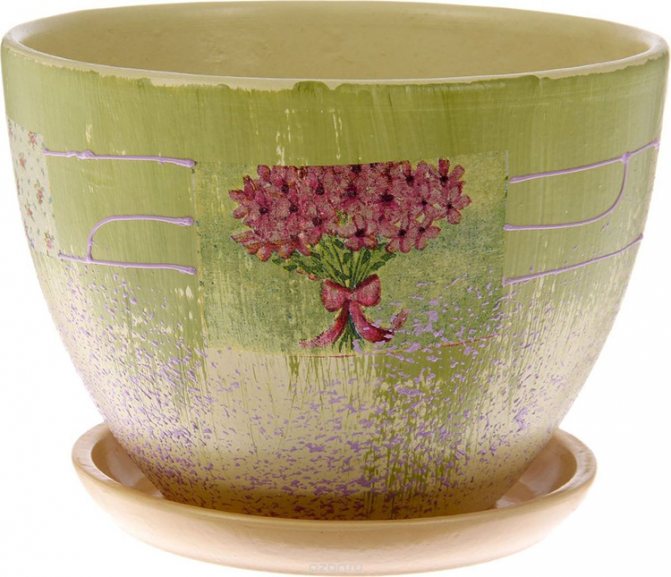

A compact pot is the best solution for a small flower
The diameter of the violet pot directly depends on the size of the flower itself. A flowerpot 9 cm deep is enough for an adult plant. Its diameter should be equal to the depth. If the saintpaulia has grown so much that it no longer fits in the allotted container, you do not need to increase its size. One has only to shake off some of the soil from the roots and transplant the plant into a similar pot. If you increase its volume, the flower may die.
Young bushes or dwarf varieties are grown in 5 × 5 or 7 × 7 pots. If you take a larger container, then there will be an active build-up of green mass, but you can not wait for a lush flowering.The soil, which the roots do not reach, begins to turn sour, and pathogenic flora develops in it. There is a universal way of choosing a pot for a room violet: its diameter should be three times less than the diameter of the rosette itself.
With regard to the material from which the pots can be made, the following can be said. On the market are containers from the most common raw materials:
- ceramics;
- plastic;
- plastic;
- clay.
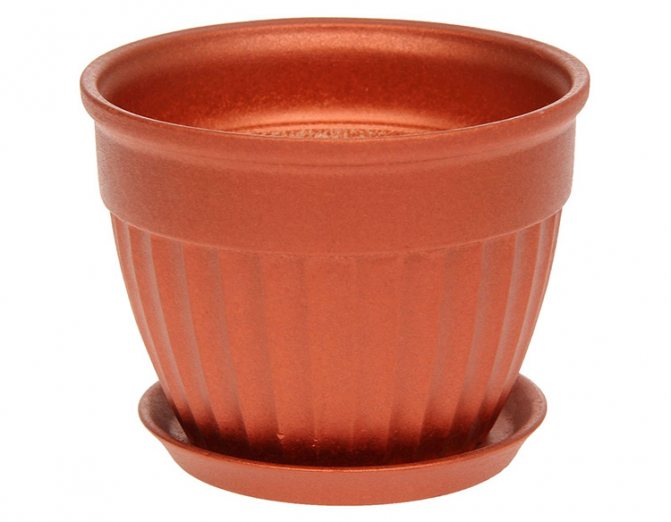

A plastic pot is more economical than ceramic, but no less functional
From a plant health point of view, it is better to choose pots made of plastic or clay for growing violets. The rest of the options do not allow air to pass through, and, accordingly, cannot ensure the normal development of the root system. The brightly colored plastic with aniline mixtures poison the Saintpaulia roots, causing them to die.
Soil composition
If you started thinking about how to grow a violet on your own, then you must definitely know what kind of soil it loves. Manufacturing firms offer several varieties of ready-made soil mixtures of various compositions, however, there are general criteria, from which one must build on when choosing a soil. The earth should be leafy, loose, perfectly permeable to moisture and air. The composition of the leafy ground includes fallen and well-rotted foliage.
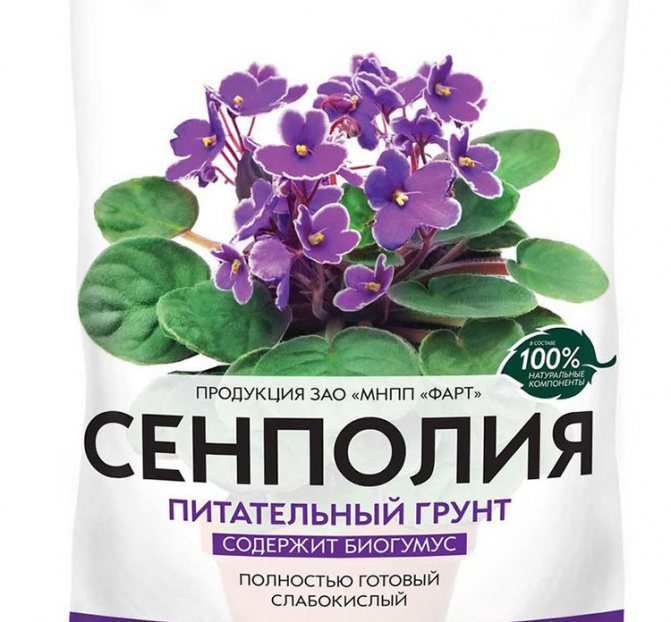

For growing violets, leafy soil with sod elements is suitable.
Sod is an obligatory component of the soil for violets. It also enters the upper layers of the nutrient mixture and is in direct contact with the root system. Coniferous soil or peat acts as fillers. They not only increase the amount of nutrients, but also make the mixture looser.
Recently, coconut fiber has been included in the composition of the soil for violets in order to improve air and moisture permeability. Only now there is no more benefit from this component. If you do not find it in the composition of the selected soil mixture, it does not matter. But you should pay close attention to the presence of special baking powder (sphagnum moss, vermiculite, perlite).
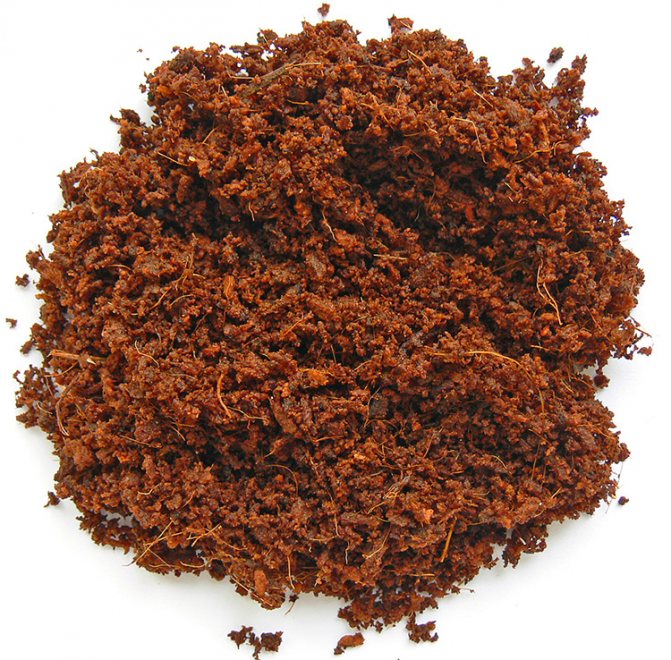

Violet feels good in soil with coconut fiber
The acidity of the soil for growing violets should be low or neutral (pH - from 5.5 to 6.5). With a decrease in this indicator, the plant ceases to absorb nitrogen and phosphorus in the required quantities, as a result of which the appearance deteriorates, diseases develop. The same applies to soil with an acidity index; in no case should it be exceeded.
Choice of location and lighting
Violets are very demanding on the level of lighting. In the conditions of a short winter day, they only slow down growth, but also stop laying buds. At the same time, the requirements for the intensity of illumination are individual for each variety. They are classified primarily by the color of the leaves.
Varieties with dark leaves tolerate bright lighting well, so they are placed in the first row on the windowsill or in the center of the lamp illuminating the rack. Varieties with light leaves are very sensitive to the sun and can easily get burned. They are tried to be placed in the second or third row on the windowsill or closer to the edges of the rack.
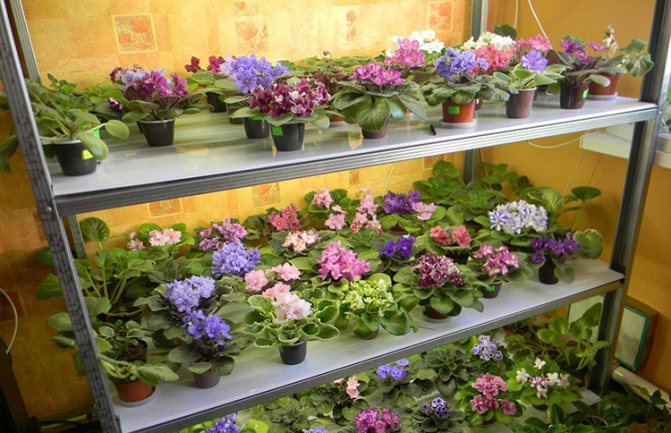

Option for placing violets on a shelf with combined lighting
Combined lighting is considered ideal for growing violets: natural daylight is complemented by fluorescent lighting. It is this combination that will give plants the spectrum they need, contributing to bright and continuous flowering. However, you do not need to be too zealous and strive to create an "eternal" day of light. After all, it is in the dark that Saintpaulias release hormones necessary for the development of buds. The best option is 16-17 hours of lighting.
Temperature and humidity
For a comfortable existence, violets need an environment with a high level of humidity - about 50%.If this condition is met, the formed peduncles will not dry out, and the blossoming buds will retain their decorative qualities longer. As a rule, the humidity level in the living quarters is lower than required. Therefore, plants must be sprayed from a spray bottle at least once a day. Another good option for maintaining high humidity is to place the pots in a container of wet sand or sphagnum moss. In this case, the main thing is not to overdo it, because with an increased level of air humidity, the processes of evaporation and exchange of moisture with the environment are disrupted.
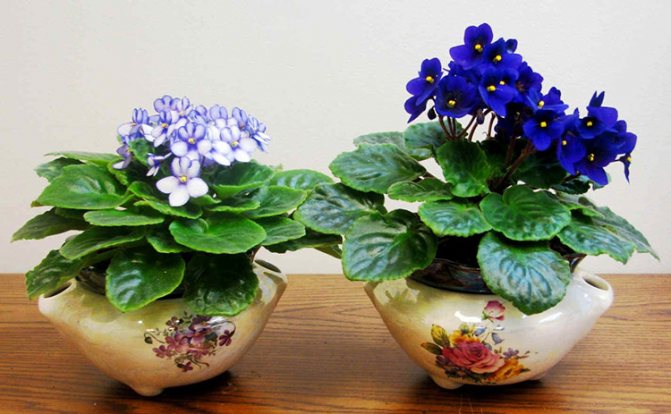

Violets with sufficient moisture
In terms of temperature, violets do not tolerate heat well. They develop most comfortably at + 20 ° C. At a lower value, the growth of the plant slows down, and its color becomes more saturated. When the temperature rises, everything happens exactly the opposite: the rosette grows faster, and the flowers are not bright enough. Fluctuations of this indicator by more than 10 ° С per day are undesirable. Not only will the appearance of the violet be greatly affected, but also the likelihood of developing fungal diseases increases.
How to water indoor violets
How to properly water violets at home? To do this, use several basic methods:
- watering from above to the edge of the pot;
- watering into a pallet;
- humidification through mats;
- wick method.
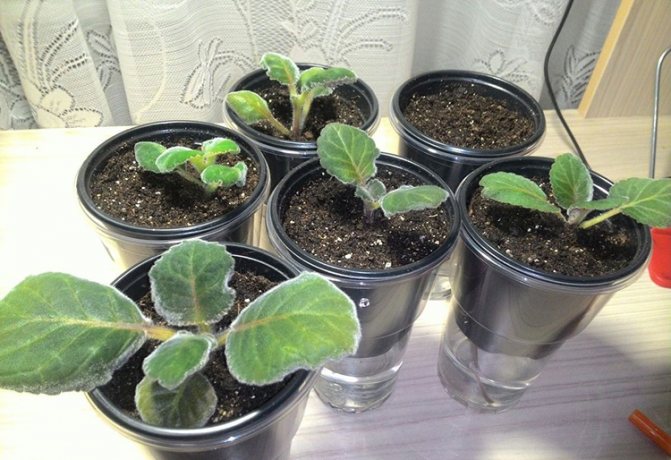

Wick method of watering violets
Recently, flower growers are increasingly resorting to using the second and last technique. In order to water the plants through a tray, pots are placed in it and water is poured. After half an hour, the pots are removed, and the excess liquid is drained. The wick method allows the violet to regulate itself how much water it needs. You need to take any synthetic cord, one end of which should be brought out through the bottom, and the other should be left approximately in the middle of the pot and covered with soil. Place the planted plant in a container of water, into which you lower the free end of the cord. The result is a capillary moisturizing effect that saves a lot of time.
Top dressing for violets at home
Over time, the nutrient content of the soil decreases markedly. The plant does not receive the necessary components, begins to grow worse, does not bloom so abundantly, gets sick. To avoid this, use feeding for violets:
- mineral;
- complex;
- organic.
With the help of mineral fertilizers, an optimal level of soil acidity is achieved, and flowering is also stimulated. They are introduced mainly during transplantation, since the granules are very poorly soluble in water.
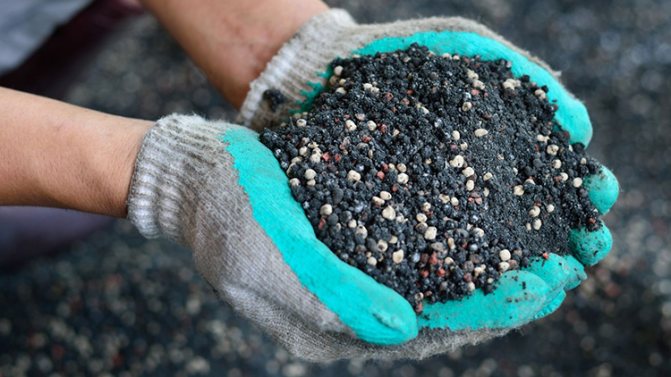

Fertilizing violets
Thanks to the introduction of complex fertilizers, the development of the root system is stimulated, a rich color of leaves and flowers is achieved, the formation of a large number of new buds is ensured, and resistance to major diseases increases. Of organic fertilizers for growing violets at home, mainly humic preparations are used. Florists also practice watering plants with water in which they washed their meat. To achieve the maximum effect, experts recommend alternating the application of organic and mineral fertilizers.
When and how to replant violets
It is recommended to replant home violets once a year. This will have a beneficial effect on both flowering and plant health. This action is necessary not only to prevent soil caking, but also to hide the bare stem. The need for a transplant can be easily determined by the presence of the following signs:
- the appearance of a white coating on the soil surface (a signal of insufficient air permeability and an excess of mineral fertilizers);
- the roots tightly wrapped around the entire earthy lump.
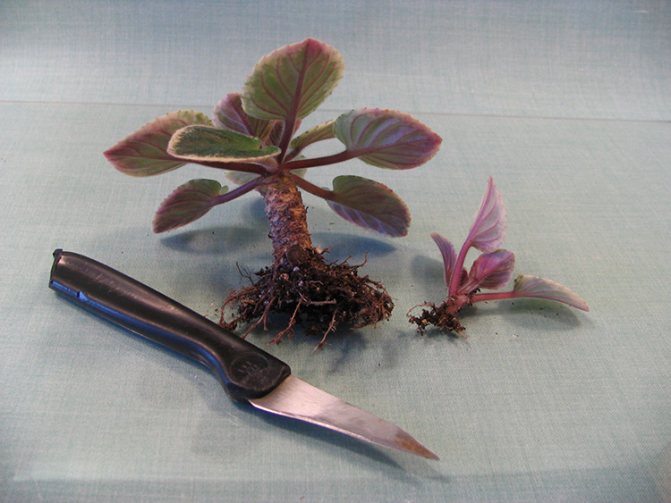

Violet transplant
The transplant is carried out at any time of the year, except for winter. This is due to insufficient lighting and short daylight hours. Do not transplant blooming violets. The only exceptions are those cases when the procedure must be carried out in order to save the plant.
The transplant is carried out by transshipping a lump of earth, moistening it a little. This will help avoid unwanted root trauma. The lower leaves should subsequently be in contact with the ground. Watering the plant right away is not worth it. To better retain moisture, cover it with a transparent plastic bag on top. Large leaves and roots can be cut a little during the transplanting process.
Caring for violets in winter at home
In winter, Saintpaulias especially need proper care. Plants need to be provided not only with comfortable temperature conditions, but also with a sufficient level of lighting and humidity. Violets are very comfortable on cloudy winter days, only their duration is short. Therefore, it is recommended to install lamps designed for this purpose over the plants and turn them on early in the morning and in the evening. The duration of daylight hours should be at least 10 hours.
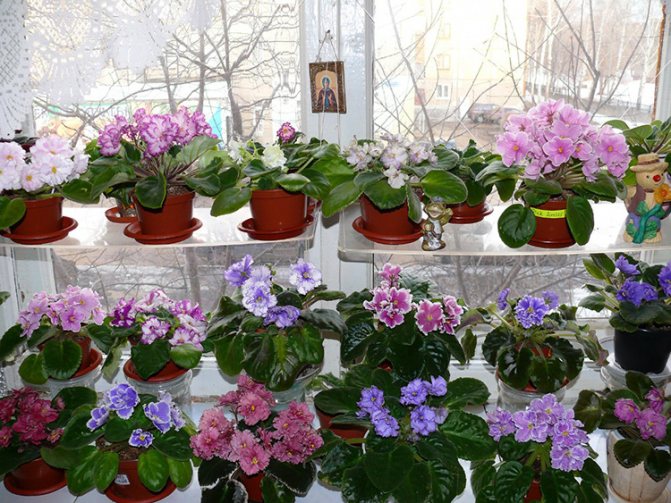

Violets in winter
Violets do not feel very good on the windowsill in winter. How to care for them so that they continue to bloom abundantly? The air in the room should not be stagnant, you need to take care of regular ventilation. Do not place the pots on a window sill above the radiator. To do this, it is good to put a table next to the window or build a special rack. To maintain optimum humidity, dishes with water are placed near the violets, an automatic humidifier is used, or the sockets are sprayed with a hand-held spray bottle.
In winter, watering violets should not be as abundant as in summer. Otherwise, decay of the root system can be achieved. The amount of fertilizer applied is also reduced. They should be produced no more than once a month.
Happiness rather than misfortune
It is not just that there are many signs and superstitions about violets, most of which have a positive connotation:
- According to Eastern philosophy, violets were grown in those houses where squabbles and disagreements took place. Blooming beauty helped to resolve conflicts
, smoothed the situation and provided the house with harmony and understanding. - If you get a violet flower, which has thick leaves, then soon the house will come financial well-being and stability
. - For the health of the newborn
there must be violets in the house. The best option would be to place a flowerpot with flowers in close proximity to the child's sleeping place. - Flowers with white petals cleanse a person's thoughts and give him peace of mind
. - Flowers with blue petals able to develop creativity in a person
. - This flower gives off a unique scent that serves as a remedy preventing insects such as ants from settling in your home
. - Flowers with red petals remove envy and negative influence from others from the house
. - Get yourself a blooming violet recommended for people who are in an unbalanced state, deprived of energy
... In this case, the flower creates a kind of lucky field that will contribute to an increase in potential, energy and performance. - Plant with pink petals attracts love, warm and tender feelings to the house
. - If a person has problems with being overweight and uncontrolled food intake, then he should definitely get a red violet, which will prevent the absorption of large amounts of food
... Also, a flower with red petals has a positive effect on getting rid of thoughts related to material status. - By the plant you can determine what feelings does a young man have for his beloved
... To do this, you must observe the donated flower. If he is growing rapidly, then the feelings of the young man are serious. If the presented violet begins to dry up, it bodes that the relationship will end soon.


If a violet located in a certain room drops leaves or dries up, this indicates that there is a heavy, bad energy in the room, which must be disposed of.
How violets reproduce
Florists actively use various methods of breeding violets in order to exchange new varieties or simply give them to each other. There is nothing complicated in this procedure, and with sufficient theoretical training, even a beginner can breed a gorgeous collection of Saintpaulias.
Seed method
This technique is the most difficult and does not give any guarantees of success. It is worth resorting to using it only if there is no other opportunity to grow a new favorite variety on your own. Pollen is collected from the blossoming buds and the pistils are pollinated with it at the moment when moisture is released on them. The seed pods will form in about a month. They must be collected and then dried well for 4 months.


Reproduction of violets by seeds
The container prepared in advance is filled with perlite. Mix the seeds thoroughly with sand and sow in the ground. It is not necessary to fill them over with a layer of soil; it is better to water them from a spray bottle. Cover the plantings with glass and set the container under the phytolamp. Subsequently, the glass must be lifted daily and the accumulated condensate removed. As soon as the seedlings reach a size of 5 mm, they should be dived into separate cups and grown as independent plants.
Reproduction of violets with a leaf with a petiole
This method is the simplest, most convenient and popular. Even so, it is possible to fail if you do something wrong. First of all, you need to choose a healthy leaf (or several), preferably from the second row from the bottom. It can be rooted in water or directly in the soil. Young leaves do not have an adequate supply of nutrients, so the chances of successful rooting are slim.
Before rooting, the cut should dry out a little, after which it is treated with activated carbon. A mixture of ordinary and distilled water or ordinary water disinfected with activated carbon is prepared. No more than 1 cm of such liquid is poured into a glass and a petiole is placed in it. Transfer the dishes to the windowsill without direct sunlight. Periodically add water as it evaporates. After a few weeks, roots form on the petiole, which should get stronger well.


Reproduction of violets with petioles
A leaf with roots is planted in the ground, watered and covered with transparent cellophane. After a certain time, it will begin to grow, releasing new plants from the root. As soon as they grow up to 5 mm, you can start picking new bushes into separate pots.
Branch of daughter sockets
This method has found wide application in the reproduction of chimeras, since it allows daughter plants not to lose the unique color of flowers. In general, the procedure is similar to propagation by cuttings, only you need to root not a leaf, but a stepson.
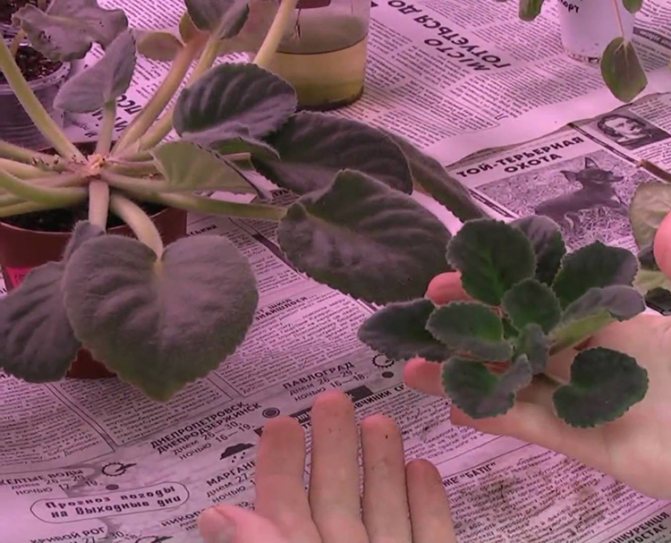

Reproduction of violets by rosettes
It is noteworthy that with this method of reproduction, chimeras may not show their unique color in the first flowering, but in subsequent ones they reveal in all their glory.
Negative prejudice
There are a number of negative superstitions about the violet in the house. Popular signs warn:
1. The flower has a feminine energy, because of which the lady may feel unnecessary. The character of a man softens, and this does not always have a good effect on family relationships.
2.Some beliefs claim that you cannot buy a flower from unfamiliar women, especially unpleasant and suspicious ones. It is believed that such a purchase can cause a permanent bad mood.
3. Unmarried girls often ask if it is possible to keep violets in the apartment. Superstitious people fear that this plant will scare off a potential groom, and call him "muzhegon". Despite this, experts say that such a judgment is unfounded. The plant does not affect personal life in any way, and a couple of beautiful flowers will be very useful in the house of a caring hostess.
4. Violet is often called a vampire. She is said to suck the vitality of the people who sleep next to her. Therefore, the flower is not recommended to be placed at the head of the bed or in the bedroom. After sleep, you may experience discomfort and discomfort. This feature is easily explained from the point of view of biology.
It is known that plants do not produce oxygen at night, but absorb it. They emit carbon dioxide, which in large quantities can cause poisoning, and in small doses leads to physical discomfort. This problem can be easily solved by moving the flower to a room where no one sleeps, or to the kitchen.
5. Since ancient times, violets have been grown on graves, which has led to the plant's "notoriety". There are people who still consider the flower to be an unkind symbol, foreshadowing the loss of loved ones or discord in the family. In fact, the flower was planted on graves to calm grieving hearts. The misinterpretation of such a tradition has given rise to negative prejudices.
Psychologists argue that belief in such superstitions determines their impact on fate. If a person concentrates on the positive aspects, he will happily observe a blooming decoration in the house. At the same time, it is recommended to correctly select the place where to put the plant. The violet will be out of place in the bedroom, but at work, as well as in the office or in the kitchen, it will wonderfully complement the interior!
Write your opinion
Violets are perhaps the most common flowers found in every second home in our country.
Indeed, in addition to the fact that flowers delight the eye with blossoming buds of all kinds of flowers, the aroma of which is difficult to confuse with others, they are not picky in care and do not require much attention.
This attracts people to decorate the windowsills in their homes with these beautiful flowers.
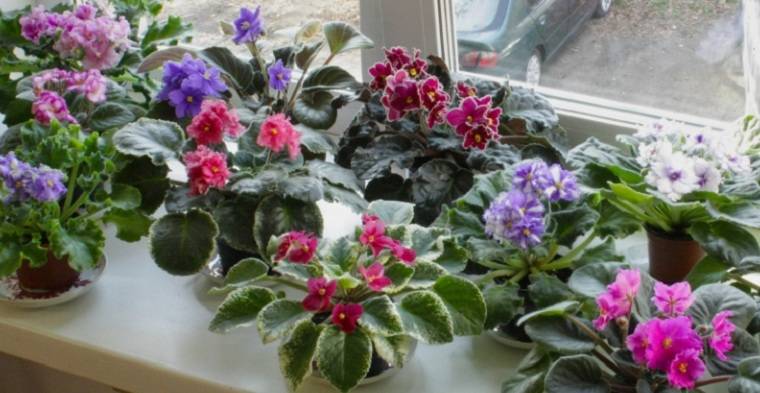

What pests are afraid of a violet
All plants have a fairly high risk of pests entering the field of vision. Here is a list of traditional houseplant sores.
- ticks;
- shield;
- thrips;
- nematodes;
- mealybug;
- aphid.


Violet infested with ticks
The best treatment is prevention, this rule fully applies to flowers. It is important to inspect the plants regularly. This is done especially carefully in spring and summer, when the air flow can bring harmful spores to the plant. Also, pests can penetrate along with a new plant bought in the store or brought cut flowers. At the slightest change in the appearance of the violet, one should begin to carry out prophylaxis against the most common pests. It is necessary to inspect the bushes with special care, noting and analyzing every detail.
Diseases of violets and their treatment - photos of damages
Saintpaulias are very delicate and fragile plants that are prone to a variety of diseases. But still, florists massively grow magnificent violets. Leaf diseases, photos and reasons will help readers figure out how dangerous a particular disease is, and also enable a person to react in time and save a beloved bush from death.
Why violet leaves turn yellow, and how to fix it
The owners of indoor violets noticed that their wards' leaves turn yellow from time to time. There may be several reasons for this:
- dying off of the lower fragments as a result of the natural aging process;
- insect damage;
- defeat by infectious diseases;
- incorrectly placed pots;
- unsuitable soil;
- violation of the regime of watering and feeding.
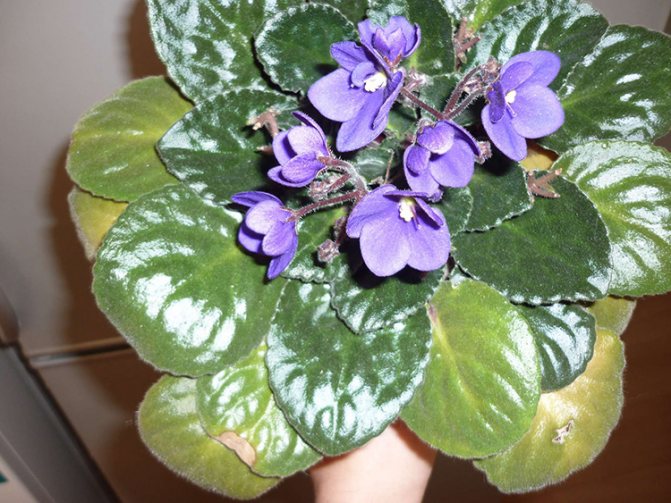

Violets can "hurt" due to waterlogging or dryness
If the lower tier of the rosette begins to turn yellow, then the reason is, most likely, depleted soil. You can cope with this trouble by transplanting a plant. If it is not possible to urgently transplant a bush, then a few grains of citric acid or a couple of drops of vinegar are added to the water for irrigation. This will help the nutrients dissolve better and normalize acidity. But in the future, it is still better to transplant the violet.
What to do if stains appear on the sheets
The appearance of spots on violet leaves is a cause for alarm. The reason can be both banal improper watering and the negative impact of parasites. Also, the wrong choice of the location of the pot can provoke such a phenomenon. It is not possible to quickly and correctly determine the cause of the stains. It is worth taking a closer look and determining their nature.
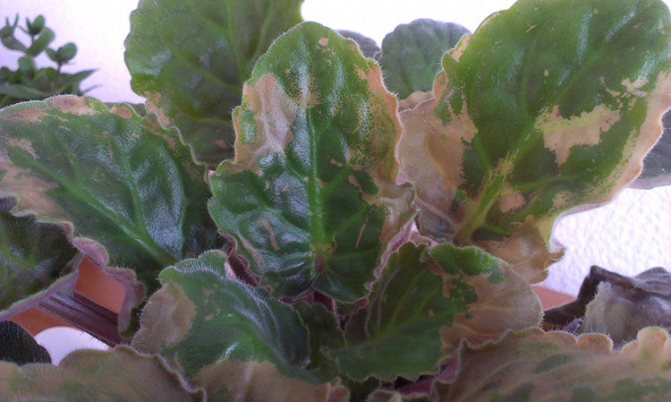

Yellow-brown spots may appear due to parasites
Yellow-brown spots indicate sunburn and an abundance of light. First of all, the edges of the leaflet are affected. The most affected is the side of the bush that is closest to the light source. To eliminate this phenomenon, it is necessary to provide the violet with partial shade, to protect it from direct sunlight.
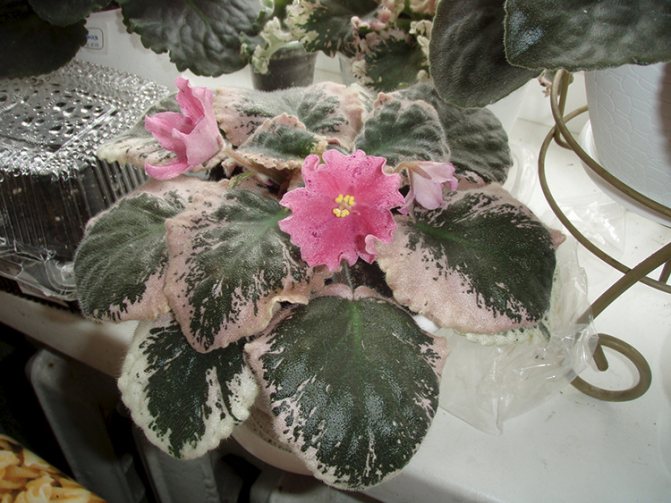

Violet infested with powdery mildew
Spots of white, similar to dusting with flour, are an alarming signal of the development of a fungal disease (powdery mildew). The plant must be separated from healthy plants and disinfected with special preparations.
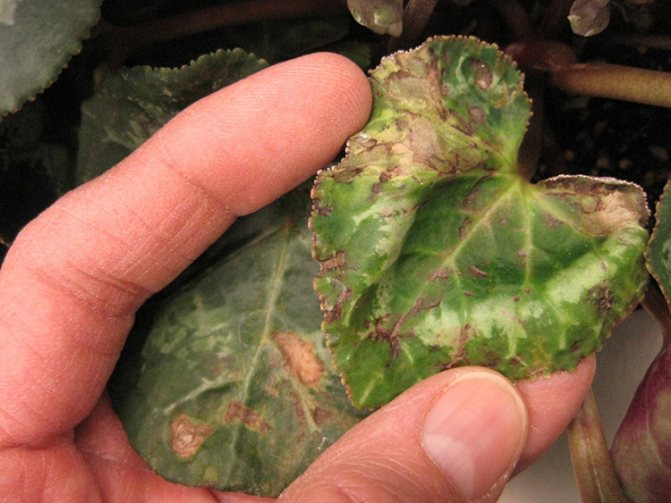

Brown spots are a sign that the plant is suffering from a lack of moisture
Brown spots indicate insufficient moisture. This is not necessarily due to poor watering. It's just that the soil is no longer able to retain the necessary moisture. Transplanting into a new soil mixture and removing the affected leaves will help to solve the problem. The reason for the appearance of spots after wintering can be an elementary lack of vitamins and nutrients. In this case, the violet should be pampered with complex fertilizers.
Why violets do not bloom, and how to care for them to bloom
The main reason that violet does not bloom, there is insufficient lighting or too short daylight hours. The plant loves bright lighting, but does not tolerate direct sunlight. The length of daylight hours should be at least 10-12 hours. To solve this problem, it is recommended to build a rack with artificial lighting located near the window.
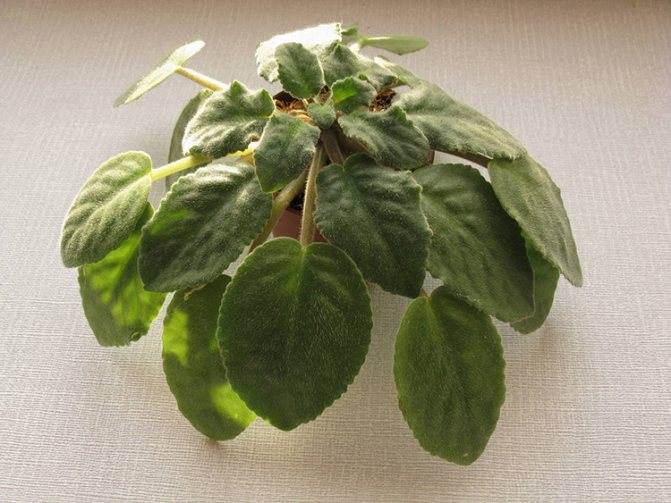

The plant may not bloom due to stress or a change in its usual place.
Incorrectly sized pot is also the reason for the long absence of peduncle formation in violets. The fact is that the plant blooms only when its root system is entwined with an earthen lump in a pot. If the capacity is too large, then flowering can be expected for a very long time.
Lack of colors - the first sign of the development of such a dangerous disease as root rot. You will have to get the bush out of the pot and carefully examine its root system. If the suspicions are confirmed, then the "head" of the violet is cut off and re-rooted. Otherwise, the plant will die.
Is it possible to keep violets at home is it good or bad folk omens, superstitions
According to superstition, violets provoke negative reactions
, in more detail:
- They have a bad effect on the emotional mood, in particular, flowers provoke a bad mood, quarrels, conflicts in the family.
- They carry a strong feminine energy, as a result of which the ladies who live in the house feel useless, and the men become depressed and spineless.
- For some reason, such flowers are also considered grave flowers; before they were planted in the cemetery in order to calm the souls of the departed. Therefore, carrying these plants into the house is a bad omen.
Despite all of the above, there are still signs from the past and opposite to the negative, in particular:
- According to oriental signs, the presence of a violet in the house contributes to the reign of peace, harmony in the family hearth. The flowers of the plant pacify those around them, smooth out conflict situations.
- If there is an acute shortage of money in the family, then the flower attracts flows of monetary energy. This is the statement of the Eastern sages.
- Flowers of white color - drive away suffering, relieve the owners of the house from bad thoughts.
- To attract money and curb your appetite, "acquire" violets with red flowers.
- Blue violets have a positive effect on people with creative potential and inspire them to create new works of art.
- Among other things, to drive out uninvited guests - ants from the house, put a violet on the windowsill. You won't see these annoying insects again.


